Cross-Cultural Miscommunication in Business: A Case Study of Expanding Business in China
VerifiedAdded on 2023/06/13
|9
|2025
|52
AI Summary
The paper discusses the potential cross-cultural miscommunication that can be faced by any business while expanding in China. It is based on a case scenario of Mary, who owns a small home business manufacturing and is willing to expand in the Chinese market. The paper uses Hofstede’s cultural dimensions to analyze the differences between Australian and Chinese business etiquette.
Contribute Materials
Your contribution can guide someone’s learning journey. Share your
documents today.

Business Communication
Secure Best Marks with AI Grader
Need help grading? Try our AI Grader for instant feedback on your assignments.

Business Communication 1
Business Communication
The aim of the paper is to reflect areas of the potential cross-cultural miscommunication that can
be faced by any business. The paper is based on the Case scenario of Mary, who owns a small
home business manufacturing along with the small factory in Wagga Wagga. Mary is now
willing to expand their business in the market of China due to which she decided to meet Mr.
Lau a fifty-five-year-old Chinese man. She has decided to expand the business in the China
market because there are few organic products that are produced by her are popular in Chinese
market due to which she is looking for expansion. Though, this is the fact that Mary is not so
certain about how to conduct business with the Chinese. Thus, this is important for Mary to get
the details related to the potential of the cross-cultural miscommunication through Hofstede’s
cultural dimensions.
Hofstede’s Culture dimension theory is a major framework that is essential for the cross-cultural
communication and this framework is developed by Geert Hofstede (Beugelsdijk, Kostova &
Roth, 2017). This theory represents the effects of a society's culture on the values of its member
and also how these values are related to the behavior using a structure derives from the factor
analysis. There are 6 dimensions that are involved in the Hofstede’s culture dimension.
Business Communication
The aim of the paper is to reflect areas of the potential cross-cultural miscommunication that can
be faced by any business. The paper is based on the Case scenario of Mary, who owns a small
home business manufacturing along with the small factory in Wagga Wagga. Mary is now
willing to expand their business in the market of China due to which she decided to meet Mr.
Lau a fifty-five-year-old Chinese man. She has decided to expand the business in the China
market because there are few organic products that are produced by her are popular in Chinese
market due to which she is looking for expansion. Though, this is the fact that Mary is not so
certain about how to conduct business with the Chinese. Thus, this is important for Mary to get
the details related to the potential of the cross-cultural miscommunication through Hofstede’s
cultural dimensions.
Hofstede’s Culture dimension theory is a major framework that is essential for the cross-cultural
communication and this framework is developed by Geert Hofstede (Beugelsdijk, Kostova &
Roth, 2017). This theory represents the effects of a society's culture on the values of its member
and also how these values are related to the behavior using a structure derives from the factor
analysis. There are 6 dimensions that are involved in the Hofstede’s culture dimension.
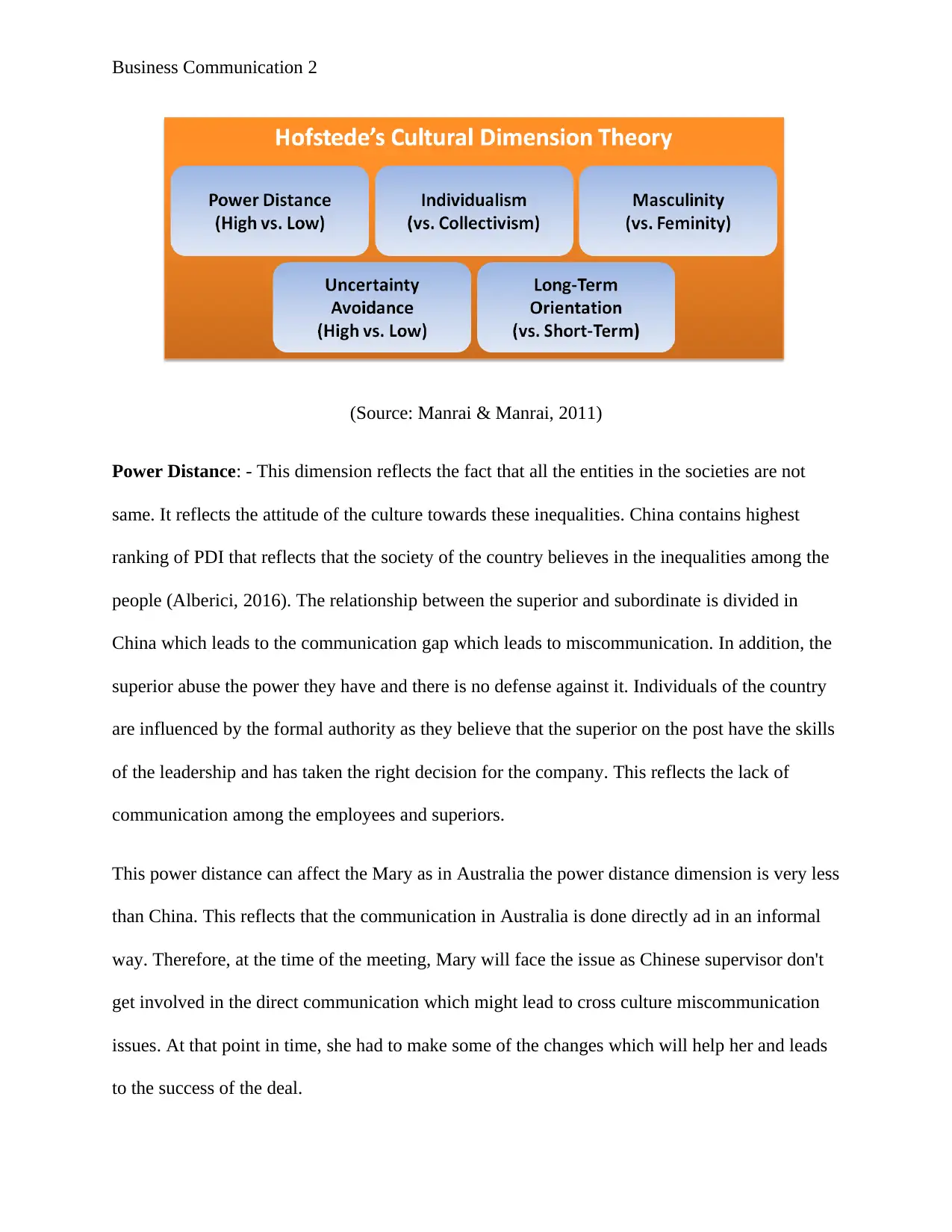
Business Communication 2
(Source: Manrai & Manrai, 2011)
Power Distance: - This dimension reflects the fact that all the entities in the societies are not
same. It reflects the attitude of the culture towards these inequalities. China contains highest
ranking of PDI that reflects that the society of the country believes in the inequalities among the
people (Alberici, 2016). The relationship between the superior and subordinate is divided in
China which leads to the communication gap which leads to miscommunication. In addition, the
superior abuse the power they have and there is no defense against it. Individuals of the country
are influenced by the formal authority as they believe that the superior on the post have the skills
of the leadership and has taken the right decision for the company. This reflects the lack of
communication among the employees and superiors.
This power distance can affect the Mary as in Australia the power distance dimension is very less
than China. This reflects that the communication in Australia is done directly ad in an informal
way. Therefore, at the time of the meeting, Mary will face the issue as Chinese supervisor don't
get involved in the direct communication which might lead to cross culture miscommunication
issues. At that point in time, she had to make some of the changes which will help her and leads
to the success of the deal.
(Source: Manrai & Manrai, 2011)
Power Distance: - This dimension reflects the fact that all the entities in the societies are not
same. It reflects the attitude of the culture towards these inequalities. China contains highest
ranking of PDI that reflects that the society of the country believes in the inequalities among the
people (Alberici, 2016). The relationship between the superior and subordinate is divided in
China which leads to the communication gap which leads to miscommunication. In addition, the
superior abuse the power they have and there is no defense against it. Individuals of the country
are influenced by the formal authority as they believe that the superior on the post have the skills
of the leadership and has taken the right decision for the company. This reflects the lack of
communication among the employees and superiors.
This power distance can affect the Mary as in Australia the power distance dimension is very less
than China. This reflects that the communication in Australia is done directly ad in an informal
way. Therefore, at the time of the meeting, Mary will face the issue as Chinese supervisor don't
get involved in the direct communication which might lead to cross culture miscommunication
issues. At that point in time, she had to make some of the changes which will help her and leads
to the success of the deal.
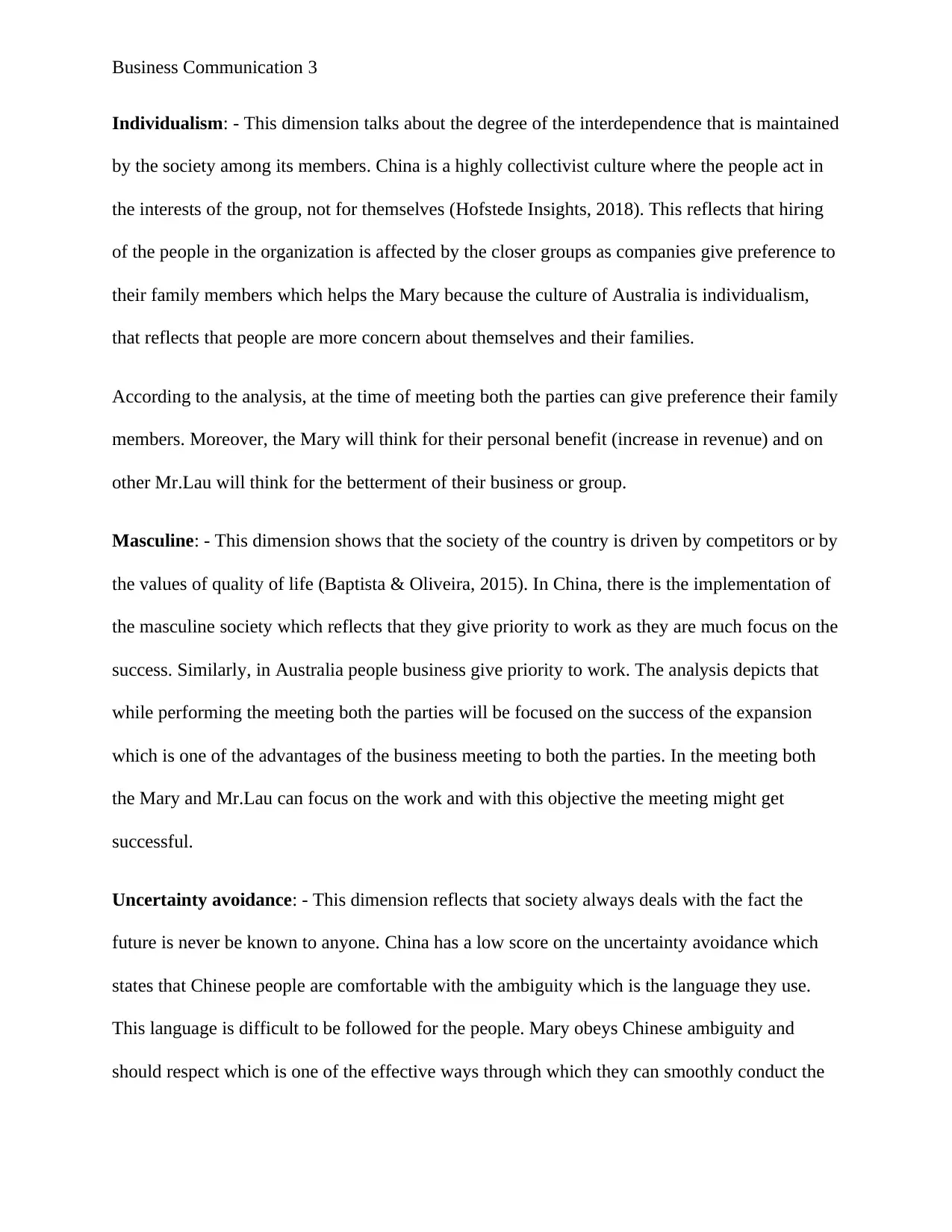
Business Communication 3
Individualism: - This dimension talks about the degree of the interdependence that is maintained
by the society among its members. China is a highly collectivist culture where the people act in
the interests of the group, not for themselves (Hofstede Insights, 2018). This reflects that hiring
of the people in the organization is affected by the closer groups as companies give preference to
their family members which helps the Mary because the culture of Australia is individualism,
that reflects that people are more concern about themselves and their families.
According to the analysis, at the time of meeting both the parties can give preference their family
members. Moreover, the Mary will think for their personal benefit (increase in revenue) and on
other Mr.Lau will think for the betterment of their business or group.
Masculine: - This dimension shows that the society of the country is driven by competitors or by
the values of quality of life (Baptista & Oliveira, 2015). In China, there is the implementation of
the masculine society which reflects that they give priority to work as they are much focus on the
success. Similarly, in Australia people business give priority to work. The analysis depicts that
while performing the meeting both the parties will be focused on the success of the expansion
which is one of the advantages of the business meeting to both the parties. In the meeting both
the Mary and Mr.Lau can focus on the work and with this objective the meeting might get
successful.
Uncertainty avoidance: - This dimension reflects that society always deals with the fact the
future is never be known to anyone. China has a low score on the uncertainty avoidance which
states that Chinese people are comfortable with the ambiguity which is the language they use.
This language is difficult to be followed for the people. Mary obeys Chinese ambiguity and
should respect which is one of the effective ways through which they can smoothly conduct the
Individualism: - This dimension talks about the degree of the interdependence that is maintained
by the society among its members. China is a highly collectivist culture where the people act in
the interests of the group, not for themselves (Hofstede Insights, 2018). This reflects that hiring
of the people in the organization is affected by the closer groups as companies give preference to
their family members which helps the Mary because the culture of Australia is individualism,
that reflects that people are more concern about themselves and their families.
According to the analysis, at the time of meeting both the parties can give preference their family
members. Moreover, the Mary will think for their personal benefit (increase in revenue) and on
other Mr.Lau will think for the betterment of their business or group.
Masculine: - This dimension shows that the society of the country is driven by competitors or by
the values of quality of life (Baptista & Oliveira, 2015). In China, there is the implementation of
the masculine society which reflects that they give priority to work as they are much focus on the
success. Similarly, in Australia people business give priority to work. The analysis depicts that
while performing the meeting both the parties will be focused on the success of the expansion
which is one of the advantages of the business meeting to both the parties. In the meeting both
the Mary and Mr.Lau can focus on the work and with this objective the meeting might get
successful.
Uncertainty avoidance: - This dimension reflects that society always deals with the fact the
future is never be known to anyone. China has a low score on the uncertainty avoidance which
states that Chinese people are comfortable with the ambiguity which is the language they use.
This language is difficult to be followed for the people. Mary obeys Chinese ambiguity and
should respect which is one of the effective ways through which they can smoothly conduct the
Secure Best Marks with AI Grader
Need help grading? Try our AI Grader for instant feedback on your assignments.
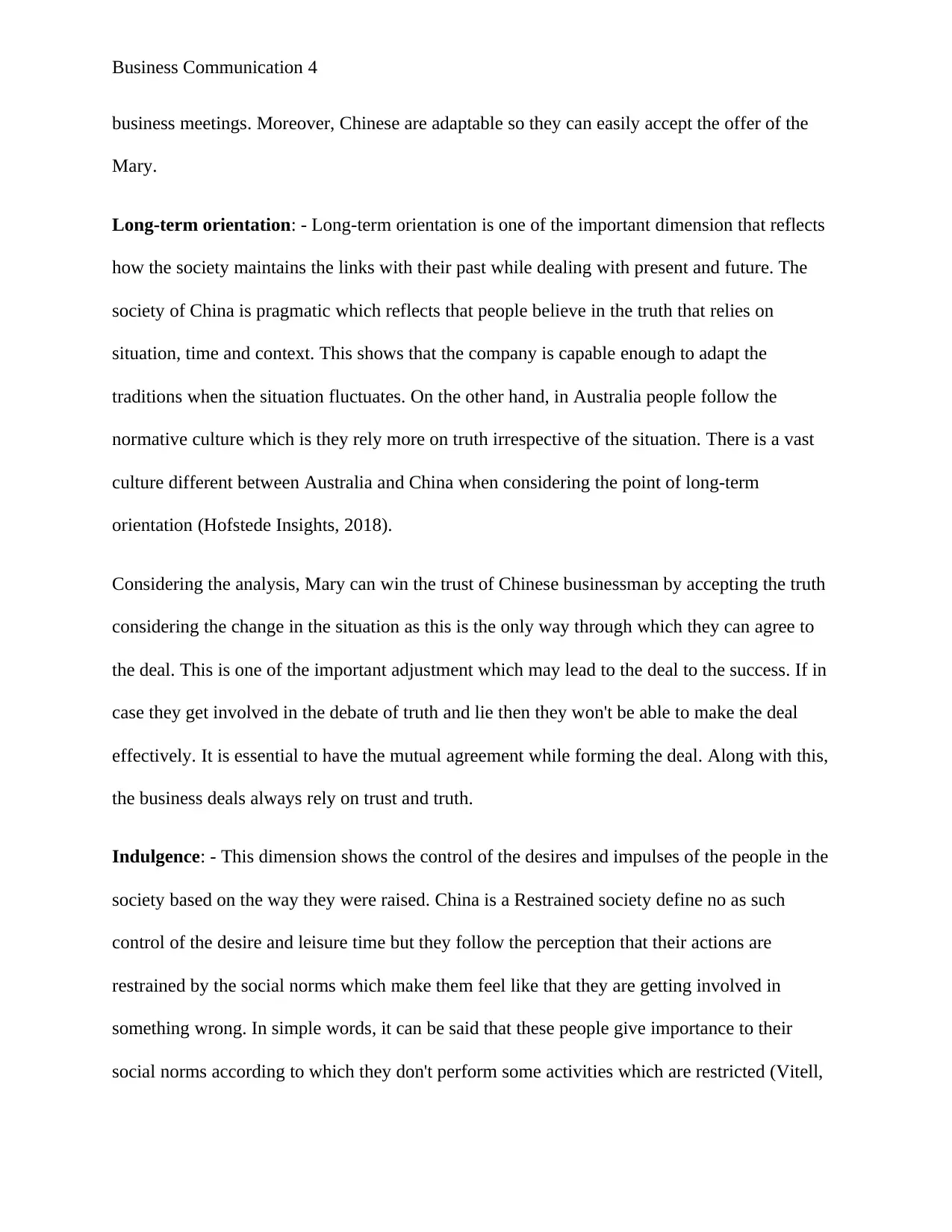
Business Communication 4
business meetings. Moreover, Chinese are adaptable so they can easily accept the offer of the
Mary.
Long-term orientation: - Long-term orientation is one of the important dimension that reflects
how the society maintains the links with their past while dealing with present and future. The
society of China is pragmatic which reflects that people believe in the truth that relies on
situation, time and context. This shows that the company is capable enough to adapt the
traditions when the situation fluctuates. On the other hand, in Australia people follow the
normative culture which is they rely more on truth irrespective of the situation. There is a vast
culture different between Australia and China when considering the point of long-term
orientation (Hofstede Insights, 2018).
Considering the analysis, Mary can win the trust of Chinese businessman by accepting the truth
considering the change in the situation as this is the only way through which they can agree to
the deal. This is one of the important adjustment which may lead to the deal to the success. If in
case they get involved in the debate of truth and lie then they won't be able to make the deal
effectively. It is essential to have the mutual agreement while forming the deal. Along with this,
the business deals always rely on trust and truth.
Indulgence: - This dimension shows the control of the desires and impulses of the people in the
society based on the way they were raised. China is a Restrained society define no as such
control of the desire and leisure time but they follow the perception that their actions are
restrained by the social norms which make them feel like that they are getting involved in
something wrong. In simple words, it can be said that these people give importance to their
social norms according to which they don't perform some activities which are restricted (Vitell,
business meetings. Moreover, Chinese are adaptable so they can easily accept the offer of the
Mary.
Long-term orientation: - Long-term orientation is one of the important dimension that reflects
how the society maintains the links with their past while dealing with present and future. The
society of China is pragmatic which reflects that people believe in the truth that relies on
situation, time and context. This shows that the company is capable enough to adapt the
traditions when the situation fluctuates. On the other hand, in Australia people follow the
normative culture which is they rely more on truth irrespective of the situation. There is a vast
culture different between Australia and China when considering the point of long-term
orientation (Hofstede Insights, 2018).
Considering the analysis, Mary can win the trust of Chinese businessman by accepting the truth
considering the change in the situation as this is the only way through which they can agree to
the deal. This is one of the important adjustment which may lead to the deal to the success. If in
case they get involved in the debate of truth and lie then they won't be able to make the deal
effectively. It is essential to have the mutual agreement while forming the deal. Along with this,
the business deals always rely on trust and truth.
Indulgence: - This dimension shows the control of the desires and impulses of the people in the
society based on the way they were raised. China is a Restrained society define no as such
control of the desire and leisure time but they follow the perception that their actions are
restrained by the social norms which make them feel like that they are getting involved in
something wrong. In simple words, it can be said that these people give importance to their
social norms according to which they don't perform some activities which are restricted (Vitell,
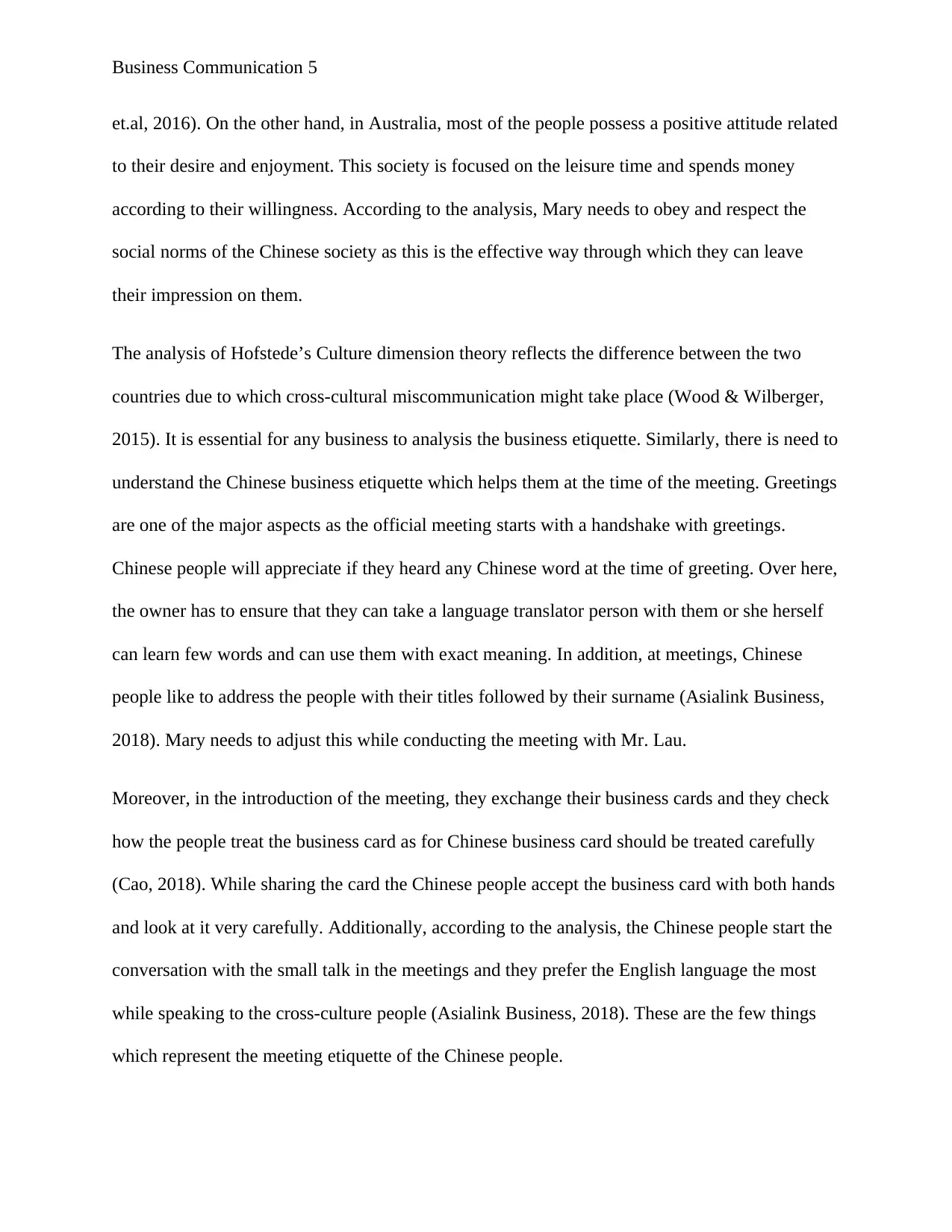
Business Communication 5
et.al, 2016). On the other hand, in Australia, most of the people possess a positive attitude related
to their desire and enjoyment. This society is focused on the leisure time and spends money
according to their willingness. According to the analysis, Mary needs to obey and respect the
social norms of the Chinese society as this is the effective way through which they can leave
their impression on them.
The analysis of Hofstede’s Culture dimension theory reflects the difference between the two
countries due to which cross-cultural miscommunication might take place (Wood & Wilberger,
2015). It is essential for any business to analysis the business etiquette. Similarly, there is need to
understand the Chinese business etiquette which helps them at the time of the meeting. Greetings
are one of the major aspects as the official meeting starts with a handshake with greetings.
Chinese people will appreciate if they heard any Chinese word at the time of greeting. Over here,
the owner has to ensure that they can take a language translator person with them or she herself
can learn few words and can use them with exact meaning. In addition, at meetings, Chinese
people like to address the people with their titles followed by their surname (Asialink Business,
2018). Mary needs to adjust this while conducting the meeting with Mr. Lau.
Moreover, in the introduction of the meeting, they exchange their business cards and they check
how the people treat the business card as for Chinese business card should be treated carefully
(Cao, 2018). While sharing the card the Chinese people accept the business card with both hands
and look at it very carefully. Additionally, according to the analysis, the Chinese people start the
conversation with the small talk in the meetings and they prefer the English language the most
while speaking to the cross-culture people (Asialink Business, 2018). These are the few things
which represent the meeting etiquette of the Chinese people.
et.al, 2016). On the other hand, in Australia, most of the people possess a positive attitude related
to their desire and enjoyment. This society is focused on the leisure time and spends money
according to their willingness. According to the analysis, Mary needs to obey and respect the
social norms of the Chinese society as this is the effective way through which they can leave
their impression on them.
The analysis of Hofstede’s Culture dimension theory reflects the difference between the two
countries due to which cross-cultural miscommunication might take place (Wood & Wilberger,
2015). It is essential for any business to analysis the business etiquette. Similarly, there is need to
understand the Chinese business etiquette which helps them at the time of the meeting. Greetings
are one of the major aspects as the official meeting starts with a handshake with greetings.
Chinese people will appreciate if they heard any Chinese word at the time of greeting. Over here,
the owner has to ensure that they can take a language translator person with them or she herself
can learn few words and can use them with exact meaning. In addition, at meetings, Chinese
people like to address the people with their titles followed by their surname (Asialink Business,
2018). Mary needs to adjust this while conducting the meeting with Mr. Lau.
Moreover, in the introduction of the meeting, they exchange their business cards and they check
how the people treat the business card as for Chinese business card should be treated carefully
(Cao, 2018). While sharing the card the Chinese people accept the business card with both hands
and look at it very carefully. Additionally, according to the analysis, the Chinese people start the
conversation with the small talk in the meetings and they prefer the English language the most
while speaking to the cross-culture people (Asialink Business, 2018). These are the few things
which represent the meeting etiquette of the Chinese people.
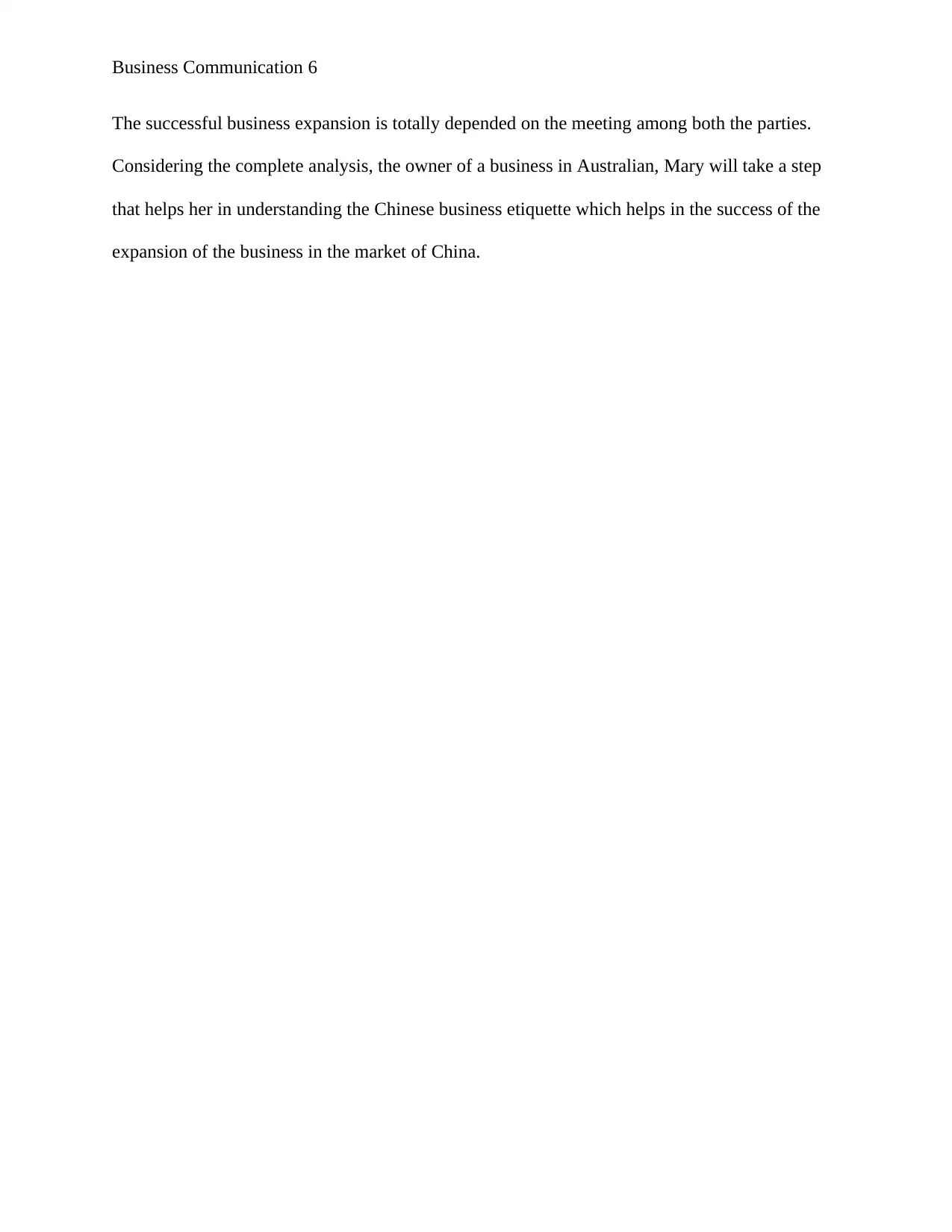
Business Communication 6
The successful business expansion is totally depended on the meeting among both the parties.
Considering the complete analysis, the owner of a business in Australian, Mary will take a step
that helps her in understanding the Chinese business etiquette which helps in the success of the
expansion of the business in the market of China.
The successful business expansion is totally depended on the meeting among both the parties.
Considering the complete analysis, the owner of a business in Australian, Mary will take a step
that helps her in understanding the Chinese business etiquette which helps in the success of the
expansion of the business in the market of China.
Paraphrase This Document
Need a fresh take? Get an instant paraphrase of this document with our AI Paraphraser
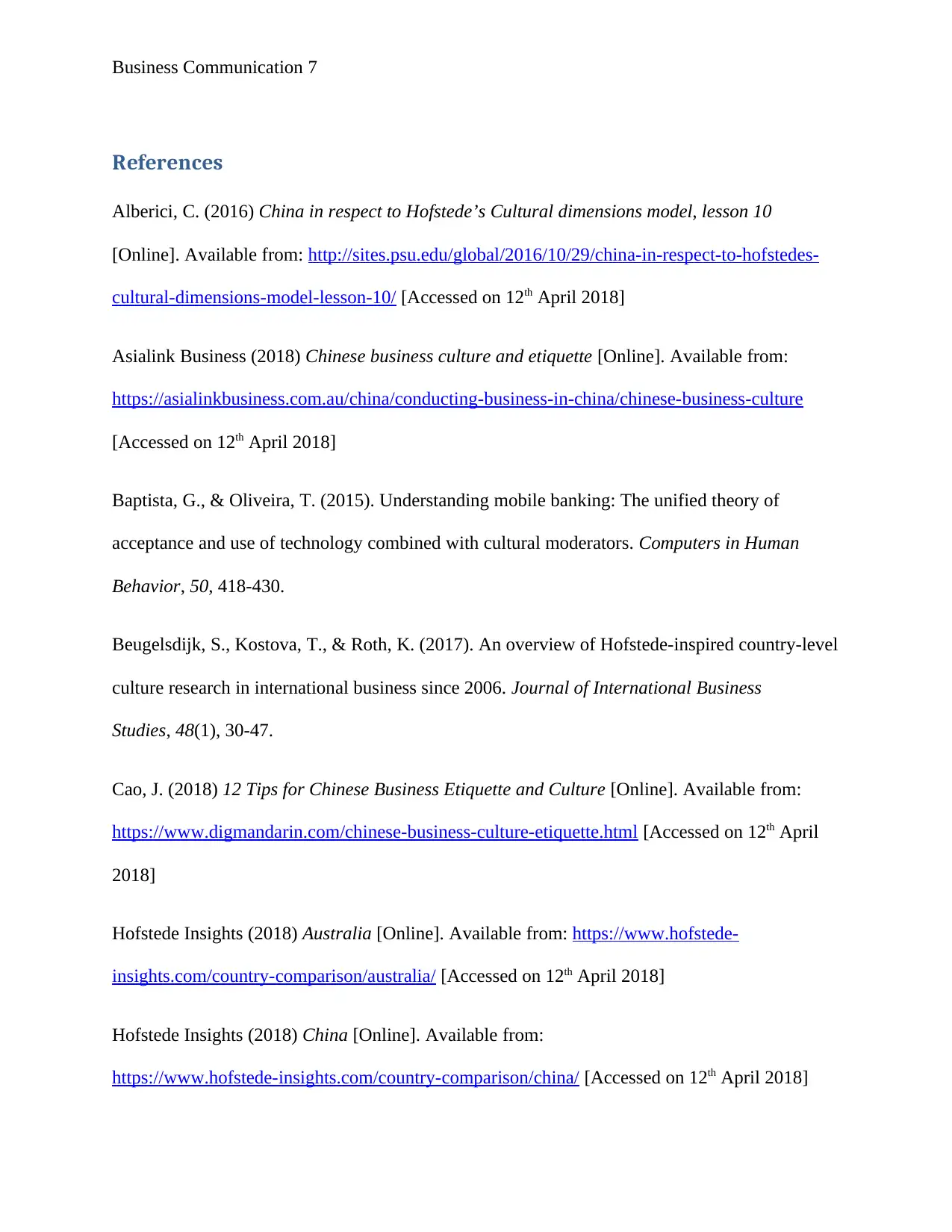
Business Communication 7
References
Alberici, C. (2016) China in respect to Hofstede’s Cultural dimensions model, lesson 10
[Online]. Available from: http://sites.psu.edu/global/2016/10/29/china-in-respect-to-hofstedes-
cultural-dimensions-model-lesson-10/ [Accessed on 12th April 2018]
Asialink Business (2018) Chinese business culture and etiquette [Online]. Available from:
https://asialinkbusiness.com.au/china/conducting-business-in-china/chinese-business-culture
[Accessed on 12th April 2018]
Baptista, G., & Oliveira, T. (2015). Understanding mobile banking: The unified theory of
acceptance and use of technology combined with cultural moderators. Computers in Human
Behavior, 50, 418-430.
Beugelsdijk, S., Kostova, T., & Roth, K. (2017). An overview of Hofstede-inspired country-level
culture research in international business since 2006. Journal of International Business
Studies, 48(1), 30-47.
Cao, J. (2018) 12 Tips for Chinese Business Etiquette and Culture [Online]. Available from:
https://www.digmandarin.com/chinese-business-culture-etiquette.html [Accessed on 12th April
2018]
Hofstede Insights (2018) Australia [Online]. Available from: https://www.hofstede-
insights.com/country-comparison/australia/ [Accessed on 12th April 2018]
Hofstede Insights (2018) China [Online]. Available from:
https://www.hofstede-insights.com/country-comparison/china/ [Accessed on 12th April 2018]
References
Alberici, C. (2016) China in respect to Hofstede’s Cultural dimensions model, lesson 10
[Online]. Available from: http://sites.psu.edu/global/2016/10/29/china-in-respect-to-hofstedes-
cultural-dimensions-model-lesson-10/ [Accessed on 12th April 2018]
Asialink Business (2018) Chinese business culture and etiquette [Online]. Available from:
https://asialinkbusiness.com.au/china/conducting-business-in-china/chinese-business-culture
[Accessed on 12th April 2018]
Baptista, G., & Oliveira, T. (2015). Understanding mobile banking: The unified theory of
acceptance and use of technology combined with cultural moderators. Computers in Human
Behavior, 50, 418-430.
Beugelsdijk, S., Kostova, T., & Roth, K. (2017). An overview of Hofstede-inspired country-level
culture research in international business since 2006. Journal of International Business
Studies, 48(1), 30-47.
Cao, J. (2018) 12 Tips for Chinese Business Etiquette and Culture [Online]. Available from:
https://www.digmandarin.com/chinese-business-culture-etiquette.html [Accessed on 12th April
2018]
Hofstede Insights (2018) Australia [Online]. Available from: https://www.hofstede-
insights.com/country-comparison/australia/ [Accessed on 12th April 2018]
Hofstede Insights (2018) China [Online]. Available from:
https://www.hofstede-insights.com/country-comparison/china/ [Accessed on 12th April 2018]
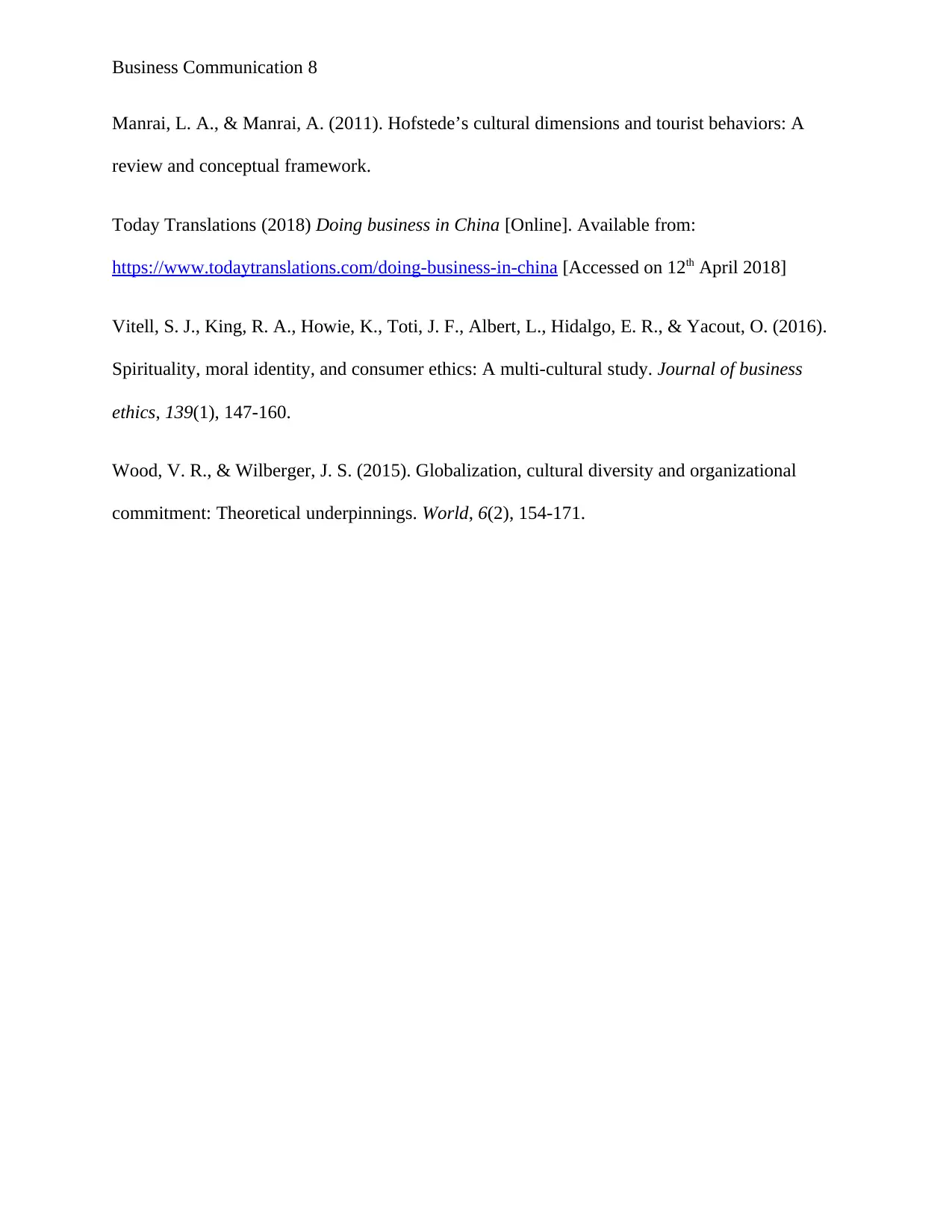
Business Communication 8
Manrai, L. A., & Manrai, A. (2011). Hofstede’s cultural dimensions and tourist behaviors: A
review and conceptual framework.
Today Translations (2018) Doing business in China [Online]. Available from:
https://www.todaytranslations.com/doing-business-in-china [Accessed on 12th April 2018]
Vitell, S. J., King, R. A., Howie, K., Toti, J. F., Albert, L., Hidalgo, E. R., & Yacout, O. (2016).
Spirituality, moral identity, and consumer ethics: A multi-cultural study. Journal of business
ethics, 139(1), 147-160.
Wood, V. R., & Wilberger, J. S. (2015). Globalization, cultural diversity and organizational
commitment: Theoretical underpinnings. World, 6(2), 154-171.
Manrai, L. A., & Manrai, A. (2011). Hofstede’s cultural dimensions and tourist behaviors: A
review and conceptual framework.
Today Translations (2018) Doing business in China [Online]. Available from:
https://www.todaytranslations.com/doing-business-in-china [Accessed on 12th April 2018]
Vitell, S. J., King, R. A., Howie, K., Toti, J. F., Albert, L., Hidalgo, E. R., & Yacout, O. (2016).
Spirituality, moral identity, and consumer ethics: A multi-cultural study. Journal of business
ethics, 139(1), 147-160.
Wood, V. R., & Wilberger, J. S. (2015). Globalization, cultural diversity and organizational
commitment: Theoretical underpinnings. World, 6(2), 154-171.
1 out of 9
Related Documents
Your All-in-One AI-Powered Toolkit for Academic Success.
+13062052269
info@desklib.com
Available 24*7 on WhatsApp / Email
![[object Object]](/_next/static/media/star-bottom.7253800d.svg)
Unlock your academic potential
© 2024 | Zucol Services PVT LTD | All rights reserved.





